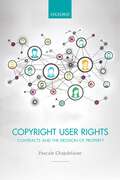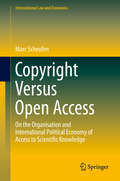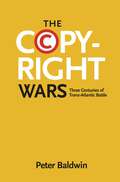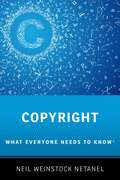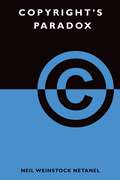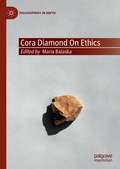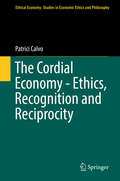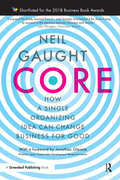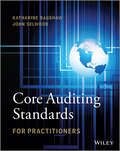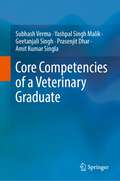- Table View
- List View
Copyright Protection of Unpublished Works in the Common Law World
by Patrick MasiyakurimaThis book discusses copyright protection of unpublished works including letters, diaries, manuscripts, photographs, memoranda, sketches, private journals, government records and drafts intended for future publication. Under contemporary British copyright law, unpublished works are protected by the Copyright, Designs and Patents Act 1988. In addition, the Berne Convention anticipates that unpublished works shall receive protection. While unpublished works are, in general, assimilated to the treatment of published ones, notable differences in the strength of protection afforded to published and unpublished works remain. It is the case that contemporary British copyright law confers stronger and longer protection on unpublished works. For instance, the unpublished status of a work assumes pivotal significance in the framework for determining: qualification for copyright protection, the extent of copyright protection, exceptions to copyright infringement and the remedies for copyright infringement.The principal aim of the book is to consider whether copyright in unpublished works is justified; a task which is prosecuted from historical, normative and legal perspectives. Although the book's primary focus is the treatment of unpublished works in Britain, it also relies extensively on materials from other Common Law jurisdictions. The book contributes to the understanding of why cumulative protection of unpublished works emerged, and how exceptions to rights in unpublished works evolved. Moreover, the analysis deployed in the book aids the task of applying the law to 'new circumstances'.
Copyright Reconstructed: Rethinking Copyright’s Economic Rights in a Time of Highly Dynamic Technological and Economic Change (Information Law Series Set)
by P. Bernt HugenholtzThe historical evolution of copyright has led to a growing disconnect between the legal definitions of economic rights and the business and technological realities they regulate, eroding copyright’s normative content and distorting the scope of its economic rights. This book, which consolidates the results of a major trans-European research project funded by Microsoft Europe, re-examines the core economic rights protected under EU copyright law, with the aim of bringing these rights more in line with economic and technological realities. Pursuing an interdisciplinary approach combining economic and legal methods, nine of Europe’s most respected copyright scholars and economists present a variety of models for reconstructing copyright’s economic rights, focusing on five potentially copyright-relevant acts that lie at the borders of exclusive rights: - digital resale; - private copying; - hyperlinking and embedding; - cable retransmission; and - text and data mining. Offering the most incisive current thinking on copyright’s economic rights in an increasingly networked world where acts of usage of works occur on a global or regional scale rather than on a purely national territorial basis, this book will be of immeasurable value not only to academics but also to practitioners and professionals in intellectual property law, scholars in the fields of international and EU copyright law, and lawmakers and judges at the EU, national and international levels.
Copyright Reconstructed: Rethinking Copyright’s Economic Rights in a Time of Highly Dynamic Technological and Economic Change (Information Law Series Set)
by P. Bernt HugenholtzThe historical evolution of copyright has led to a growing disconnect between the legal definitions of economic rights and the business and technological realities they regulate, eroding copyright’s normative content and distorting the scope of its economic rights. This book, which consolidates the results of a major trans-European research project funded by Microsoft Europe, re-examines the core economic rights protected under EU copyright law, with the aim of bringing these rights more in line with economic and technological realities. Pursuing an interdisciplinary approach combining economic and legal methods, nine of Europe’s most respected copyright scholars and economists present a variety of models for reconstructing copyright’s economic rights, focusing on five potentially copyright-relevant acts that lie at the borders of exclusive rights: - digital resale; - private copying; - hyperlinking and embedding; - cable retransmission; and - text and data mining. Offering the most incisive current thinking on copyright’s economic rights in an increasingly networked world where acts of usage of works occur on a global or regional scale rather than on a purely national territorial basis, this book will be of immeasurable value not only to academics but also to practitioners and professionals in intellectual property law, scholars in the fields of international and EU copyright law, and lawmakers and judges at the EU, national and international levels.
The Copyright / Trademark Interface: How the Expansion of Trademark Protection Is Stifling Cultural Creativity
by Martin SenftlebenThe Copyright/Trademark Interface How the Expansion of Trademark Protection Is Stifling Cultural Creativity Martin Senftleben The registration of cultural icons as trademarks has become a standard protection strategy in the field of contemporary cultural productions and plays an ever-increasing role in the area of cultural heritage. Attempts to register and ‘evergreen’ the protection of cultural signs, ranging from ‘Mickey Mouse’ to the ‘Mona Lisa’, are no longer unusual. This phenomenon – characterized by the EFTA Court as trademark registrations motivated by ‘commercial greed’ – has become typical of an era where trademark law is employed strategically to withhold or remove cultural symbols from the public domain. In an extraordinary analysis of the clash between culture and commerce, and imbalances caused by protection overlaps arising from cumulative copyright and trademark protection, this book draws attention to the corrosive effect of indefinitely renewable trademark rights and underscores the necessity to safeguard central preconditions for the proper functioning of the copyright system in society at large: the freedom to use pre-existing works as reference points for the artistic discourse and building blocks for new creations, and the need to ensure the constant enrichment of the public domain. Emphasizing how overlapping copyright and trademark protection endangers the proper functioning of intellectual property rights in the literary and artistic domain, the author examines whether the intellectual property system is capable of mitigating the risks arising from cumulative protection. Such issues and topics as the following are treated in depth: the different configuration of intellectual property rights in accordance with different policy objectives and societal functions, in particular the cultural imperative in copyright law and the market transparency imperative in trademark law; problems arising from the registration of cultural icons for use on souvenir and merchandising articles; lack of sufficient safeguards in trademark law against cultural heritage branding; current scope of trademark rights, including the protection of brand value and communication functions, and the deterrent effect of trademark protection on cultural creativity; possibility of a categorical exclusion of contemporary cultural icons and cultural heritage material from trademark protection; development of a strict gatekeeper requirement of ‘use as a mark’ to prevent unjustified trademark infringement claims; development of robust, culturally based defences against trademark infringement claims; and general guidelines for the regulation of protection overlaps in intellectual property law, based on insights derived from the analysis of copyright/trademark overlaps. Drawing on aesthetic, sociological and economic theories that support initiatives to safeguard the autonomy of the literary and artistic domain and support remix activities of artists, the author suggests sound criteria for identifying signs with cultural significance that should be excluded from trademark registration. The book shows how intellectual property law can make rights cumulation strategies less attractive and avoid the loss of inner consistency and social legitimacy, easing the tension between indefinitely renewable trademark rights and the need to preserve and cultivate the public domain of cultural expressions and other intellectual creations that enjoy protection for a limited period of time, such as industrial designs and technical know-how. Its assessment criteria will assist and enable trademark examiners and judges to identify relevant cultural signs, and its proposals for regulatory responses to protection overlaps in intellectual property law will prove of great and lasting value to lawyers, policymakers, and scholars dealing with intellectual property law.
Copyright User Rights: Contracts and the Erosion of Property
by Pascale ChapdelaineThis is the first book to offer an in-depth investigation of the unsettled nature, scope and dynamics of copyright user rights in an increasingly dematerialized environment. Combining a detailed theoretical framework with practical applications, the book provides a comprehensive perspective on copyright user rights, exploring the nature of commercial copies of copyright works, of exceptions to copyright infringement, and how they are shaped to a large extent by traditional concepts of private law (e.g. property, goods, services, sales, and licences). Using property and contract law and theory, it addresses the competing interests of copyright holders and users in the same object, and points out the double standards in how the rights of copyright holders and copyright users are dealt with. It argues that the property component of user rights has been largely neglected and needs to be brought to the fore, to give the protection that users deserve, without neglecting the rights users should have as they increasingly experience copyright works through services. With the onset of an increasingly digital age, it emphasises how traditional concepts of private law need to adapt for adequately dealing with the dematerialization of copies of copyright works and user rights. It proposes a clearer view on the justification and nature of user rights, with possible gradations of powers for users, and suggests how courts and legislatures may address contract terms that weaken user rights. This book provides vital tools for law- and policy-makers worldwide who seek to achieve the proper balance between the competing rights and interests of copyright holders, copyright users, and the public domain.
Copyright User Rights: Contracts and the Erosion of Property
by Pascale ChapdelaineThis is the first book to offer an in-depth investigation of the unsettled nature, scope and dynamics of copyright user rights in an increasingly dematerialized environment. Combining a detailed theoretical framework with practical applications, the book provides a comprehensive perspective on copyright user rights, exploring the nature of commercial copies of copyright works, of exceptions to copyright infringement, and how they are shaped to a large extent by traditional concepts of private law (e.g. property, goods, services, sales, and licences). Using property and contract law and theory, it addresses the competing interests of copyright holders and users in the same object, and points out the double standards in how the rights of copyright holders and copyright users are dealt with. It argues that the property component of user rights has been largely neglected and needs to be brought to the fore, to give the protection that users deserve, without neglecting the rights users should have as they increasingly experience copyright works through services. With the onset of an increasingly digital age, it emphasises how traditional concepts of private law need to adapt for adequately dealing with the dematerialization of copies of copyright works and user rights. It proposes a clearer view on the justification and nature of user rights, with possible gradations of powers for users, and suggests how courts and legislatures may address contract terms that weaken user rights. This book provides vital tools for law- and policy-makers worldwide who seek to achieve the proper balance between the competing rights and interests of copyright holders, copyright users, and the public domain.
Copyright Versus Open Access: On the Organisation and International Political Economy of Access to Scientific Knowledge (International Law and Economics)
by Marc ScheufenThis book addresses the recent debate about copyright law and its impact on the distribution of scientific knowledge from an economic perspective. The focus is on the question whether a copyright regime or an open access regime is better suited to the norms and organizational structure in a purely global science community. The book undertakes a thorough economic analysis of the academic journal market and showcases consequences of a regime change. It also takes account of the Digital Divide debate, reflecting issues in developing countries. Finally, a comprehensive analysis of legal action in the light of international Intellectual Property (IP) agreements offers prospects on the future of academic publishing.
The Copyright Wars: Three Centuries of Trans-Atlantic Battle
by Peter BaldwinToday's copyright wars can seem unprecedented. Sparked by the digital revolution that has made copyright—and its violation—a part of everyday life, fights over intellectual property have pitted creators, Hollywood, and governments against consumers, pirates, Silicon Valley, and open-access advocates. But while the digital generation can be forgiven for thinking the dispute between, for example, the publishing industry and Google is completely new, the copyright wars in fact stretch back three centuries—and their history is essential to understanding today’s battles. The Copyright Wars—the first major trans-Atlantic history of copyright from its origins to today—tells this important story.Peter Baldwin explains why the copyright wars have always been driven by a fundamental tension. Should copyright assure authors and rights holders lasting claims, much like conventional property rights, as in Continental Europe? Or should copyright be primarily concerned with giving consumers cheap and easy access to a shared culture, as in Britain and America? The Copyright Wars describes how the Continental approach triumphed, dramatically increasing the claims of rights holders. The book also tells the widely forgotten story of how America went from being a leading copyright opponent and pirate in the eighteenth and nineteenth centuries to become the world’s intellectual property policeman in the late twentieth. As it became a net cultural exporter and its content industries saw their advantage in the Continental ideology of strong authors’ rights, the United States reversed position on copyright, weakening its commitment to the ideal of universal enlightenment—a history that reveals that today’s open-access advocates are heirs of a venerable American tradition.Compelling and wide-ranging, The Copyright Wars is indispensable for understanding a crucial economic, cultural, and political conflict that has reignited in our own time.
The Copyright Wars: Three Centuries of Trans-Atlantic Battle
by Peter BaldwinToday's copyright wars can seem unprecedented. Sparked by the digital revolution that has made copyright—and its violation—a part of everyday life, fights over intellectual property have pitted creators, Hollywood, and governments against consumers, pirates, Silicon Valley, and open-access advocates. But while the digital generation can be forgiven for thinking the dispute between, for example, the publishing industry and Google is completely new, the copyright wars in fact stretch back three centuries—and their history is essential to understanding today’s battles. The Copyright Wars—the first major trans-Atlantic history of copyright from its origins to today—tells this important story.Peter Baldwin explains why the copyright wars have always been driven by a fundamental tension. Should copyright assure authors and rights holders lasting claims, much like conventional property rights, as in Continental Europe? Or should copyright be primarily concerned with giving consumers cheap and easy access to a shared culture, as in Britain and America? The Copyright Wars describes how the Continental approach triumphed, dramatically increasing the claims of rights holders. The book also tells the widely forgotten story of how America went from being a leading copyright opponent and pirate in the eighteenth and nineteenth centuries to become the world’s intellectual property policeman in the late twentieth. As it became a net cultural exporter and its content industries saw their advantage in the Continental ideology of strong authors’ rights, the United States reversed position on copyright, weakening its commitment to the ideal of universal enlightenment—a history that reveals that today’s open-access advocates are heirs of a venerable American tradition.Compelling and wide-ranging, The Copyright Wars is indispensable for understanding a crucial economic, cultural, and political conflict that has reignited in our own time.
COPYRIGHT WENK C: What Everyone Needs to Know® (What Everyone Needs To Know®)
by Neil Weinstock NetanelCopyright law was once an esoteric backwater, the special province of professional authors, publishers, and media companies. This is no longer the case. In the age of social media and cloud storage, we have become a copying and sharing culture. Much of our everyday communication, work, and entertainment now directly involves copyright law. Copyright law and policy are ferociously contested. Record labels, movie studios, book publishers, newspapers, and many authors rage that those who share music, video, text, and images over the Internet are "stealing" their property. By contrast, copyright industry critics celebrate digital technology's potential to make the universe of movies, music, books, and art accessible anytime and anywhere - and to empower individuals the world over to express themselves by sharing and remixing those works. These critics argue that excessive copyright enforcement threatens that promise and stifles creativity. In Copyright: What Everyone Needs to Know®, Neil Netanel explains the concepts needed to understand the heated debates about copyright law and policy. He identifies the combatants, unpacks their arguments, and illuminates what is at stake in the debates over copyright's present and future.
Copyrighting Creativity: Creative Values, Cultural Heritage Institutions and Systems of Intellectual Property (Digital Research in the Arts and Humanities)
by Helle PorsdamWhat is the relationship between creativity, cultural heritage institutions and copyright? Who owns culture and cultural heritage? The digital age has expanded the horizon of creative possibilities for artists and cultural institutions - what is the impact on legal regimes that were constructed for an analogue world? What are the tensions between the safeguarding of cultural heritage and the dissemination of knowledge about culture? Inspired by a three year research project involving leading European universities, this book explores the relationship between copyright and intellectual property, creativity and innovation, and cultural heritage institutions. Its contributors are scholars from both the humanities and the social sciences - from cultural studies to law - as well as cultural practitioners and representatives from cultural heritage institutions. They all share an interest in the contribution of intellectual property to the role of cultural institutions in making culture accessible and encouraging new creativity.
Copyrighting Creativity: Creative Values, Cultural Heritage Institutions and Systems of Intellectual Property (Digital Research in the Arts and Humanities)
by Helle PorsdamWhat is the relationship between creativity, cultural heritage institutions and copyright? Who owns culture and cultural heritage? The digital age has expanded the horizon of creative possibilities for artists and cultural institutions - what is the impact on legal regimes that were constructed for an analogue world? What are the tensions between the safeguarding of cultural heritage and the dissemination of knowledge about culture? Inspired by a three year research project involving leading European universities, this book explores the relationship between copyright and intellectual property, creativity and innovation, and cultural heritage institutions. Its contributors are scholars from both the humanities and the social sciences - from cultural studies to law - as well as cultural practitioners and representatives from cultural heritage institutions. They all share an interest in the contribution of intellectual property to the role of cultural institutions in making culture accessible and encouraging new creativity.
Copyright's Highway: From the Printing Press to the Cloud, Second Edition
by Paul GoldsteinIn Copyright's Highway, one of the nation's leading authorities on intellectual property law offers an engaging, readable, and intelligent analysis of the effect of copyright on American politics, economy, and culture. From eighteenth-century copyright law, to the "celestial jukebox," to the future of copyright issues in the digital age, Paul Goldstein presents a thorough examination of the challenges facing copyright owners and users. In this fully updated second edition, the author expands the discussion to cover the latest developments and shifts in copyright law for a new audience of scholars and students. This expanded edition introduces readers to present and future debates regarding copyright law and policy, including a new chapter on the technological shift in emphasis from producer to consumer and the legal shift from exclusive rights to exceptions and limitations to those rights. From Gutenberg to Google Books, Copyright's Highway, Second Edition, offers a concise, essential resource for the internet generation.
Copyright’s Highway: From Gutenberg to the Celestial Jukebox, Revised Edition
by Paul GoldsteinFrom eighteenth-century copyright law, to current-day copyright issues on the internet, to tomorrow's "celestial jukebox"—a digital repository of books, movies, and music available on demand—Paul Goldstein presents a thorough examination of the challenges facing copyright owners and users. One of the nation's leading authorities on intellectual property law, Goldstein offers an engaging, readable, and intelligent analysis of the effect of copyright on American politics, economy, and culture. Goldstein presents and analyzes key legal battles, including Supreme Court decisions on home taping and 2 Live Crew's contested sampling of Roy Orbison's "Pretty Woman." In this revised edition, the author expands the discussion to cover electronic media, including an examination of recent Napster litigation, the Digital Millennium Copyright Act, and the vexed Secure Digital Music Initiative, under which record companies attempted to develop effective encryption standards for their products. Praise for the first edition: "A clever and vibrant book that traces copyright history from the invention of the printing press through current challenges to copyright from new technologies . . . . Most compelling [on] multimedia technologies." —Sabra Chartrand, The New York Times "This eminent authority writes with clarity, lucidity and a wry sense of humor about a subject whose complexities can be daunting." —Jonathan Kirsch, Los Angeles Times "A wonderfully American tale of how law, literature, politics and megabucks intersect." —William Petrocelli, San Francisco Chronicle
Copyright's Paradox
by Neil Weinstock NetanelProviding a vital economic incentive for much of society's music, art, and literature, copyright is widely considered "the engine of free expression"--but it is also used to stifle news reporting, political commentary, historical scholarship, and even artistic expression. In Copyright's Paradox, Neil Weinstock Netanel explores the tensions between copyright law and free speech, revealing the unacceptable burdens on expression that copyright can impose. Tracing the conflict across both traditional and digital media, Netanel examines the remix and copying culture at the heart of current controversies related to the Google Book Search litigation, YouTube and MySpace, hip-hop music, and digital sampling. The author juxtaposes the dramatic expansion of copyright holders' proprietary control against the individual's newly found ability to digitally cut, paste, edit, remix, and distribute sound recordings, movies, TV programs, graphics, and texts the world over. He tests whether, in light of these and other developments, copyright still serves as a vital engine of free expression and assesses how copyright does--and does not--burden free speech. Taking First Amendment values as his lodestar, Netanel offers a crucial, timely call to redefine the limits of copyright so it can most effectively promote robust debate and expressive diversity--and he presents a definitive blueprint for how this can be accomplished.
Copyright's Paradox
by Neil Weinstock NetanelProviding a vital economic incentive for much of society's music, art, and literature, copyright is widely considered "the engine of free expression"--but it is also used to stifle news reporting, political commentary, historical scholarship, and even artistic expression. In Copyright's Paradox, Neil Weinstock Netanel explores the tensions between copyright law and free speech, revealing the unacceptable burdens on expression that copyright can impose. Tracing the conflict across both traditional and digital media, Netanel examines the remix and copying culture at the heart of current controversies related to the Google Book Search litigation, YouTube and MySpace, hip-hop music, and digital sampling. The author juxtaposes the dramatic expansion of copyright holders' proprietary control against the individual's newly found ability to digitally cut, paste, edit, remix, and distribute sound recordings, movies, TV programs, graphics, and texts the world over. He tests whether, in light of these and other developments, copyright still serves as a vital engine of free expression and assesses how copyright does--and does not--burden free speech. Taking First Amendment values as his lodestar, Netanel offers a crucial, timely call to redefine the limits of copyright so it can most effectively promote robust debate and expressive diversity--and he presents a definitive blueprint for how this can be accomplished.
Cora Diamond on Ethics (Philosophers in Depth)
by Maria BalaskaThis collection offers an in-depth look at Cora Diamond’s distinctive approach to ethics and its philosophical significance. It comprises a new essay by Cora Diamond on the policing of concepts, followed by ten original chapters by world-class scholars covering conceptual loss, moral theory, the category of the human, the moral consideration of animals, and the meaning of narcissism. Including comparisons to the work of other contemporary moral philosophers such as Martha Nussbaum, Jeff McMahan, Rai Gaita, Eva Kittay, Christine Korsgaard, and Edward Harcourt, the volume also creates interdisciplinary links between Diamond’s work and other fields of study, including psychoanalysis and contemporary ethology. Showcasing the vital importance of Diamond’s contribution to philosophy, this volume is essential reading for scholars working in ethics, philosophy of language and literature.
The Cordial Economy - Ethics, Recognition and Reciprocity (Ethical Economy #55)
by Patrici CalvoThis book proposes, from a civil perspective —such as that developed by Stefano Zamagni— and a cordial perspective —such as that developed by Adela Cortina—, orientations to design an economy in tune with what the historical moment demands. Among other things, this comes from encouraging institutions, organisations and companies to include in their designs aspects as important for carrying out their activities as cordial reciprocity, mutual recognition of the communicative and affective capacities of the linked or linkable parties, public commitment and the active participation of civil society.The book first shows the conceptualisation of the process of self-interest as operating for one’s own benefit and its inclusion in the orthodox economic model. In Chapter 2 it then displays some of the logical/formal and experimental limits of the axiomatic economics model to discover the possibility of building bridges between theoretical modelling and factual validation. Chapter 3 demonstrates the fragility of a rationality model based on the paradigmatic figure of homo oeconomicus. Chapter 4 reflects on the critical process that has identified reciprocity as a determining factor for human cooperation, turning this behaviour into a paradox in which the lack of a reasonable explanation from the selfish perspective becomes inconsistent in the predominant economic theory. Chapter 5 is from a moral point of view it describes and criticises the different approaches to reciprocity observed by sociologists, biologists, psychologists and economists. Chapter 6 analyses three mutual recognition proposals as possible foundations for human cooperation, highlighting one of them –cordial recognition, developed by Cortina– because it is more closely related to studies of reciprocity, particularly the most recent contributions from the neurosciences. Chapter 7 proposes cordial reciprocity as a horizon of meaning for the various approaches to reciprocity observed. Chapter 8 explores the possible emergence and development of cordial goods, a type of relational and communicative good that enables joint actions to take place in different contexts of human activity. Chapter 9 analyses the application and implementation of cordial reciprocity at the macro, meso and micro levels of the economy. And finally, it proposes guidelines for designing a monitoring and compliance system which, based on the communication, storage and processing of big data and the committed participation of stakeholders, offers businesses the possibility of inspecting their underlying dimensions of morality, emotions and responsibility.
CORE: How a Single Organizing Idea can Change Business for Good
by Neil GaughtCORE is shortlisted for the Best Business Book Awards in the Engaging Change category. At the core of the world's most admired businesses lies a powerful Single Organizing Idea. These organizations deliver sustainable economic and social benefit; they unite people, attract investment, inspire innovation, pioneer new efficiencies, and enjoy positive reputation. Such businesses are admired but they remain a rare breed. Though the tides of change are engaging the minds of business leaders, most are still trapped behind their brands and an approach to corporate social responsibility that is out of step with a connected society that increasingly questions 'who' these businesses really are and what drives their purpose. This book is about how businesses can adopt a Single Organizing Idea and, more importantly, why they have to. Drawing on stories and case studies, and with reference to the UN's Sustainable Development Goals, its no-nonsense approach sets aside the ideals to confront the realities of business reform. It demonstrates the power and potential that a Single Organizing Idea can bring to any business prepared to take its head out of the sand and proactively respond to today's challenges.
CORE: How a Single Organizing Idea can Change Business for Good
by Neil GaughtCORE is shortlisted for the Best Business Book Awards in the Engaging Change category. At the core of the world's most admired businesses lies a powerful Single Organizing Idea. These organizations deliver sustainable economic and social benefit; they unite people, attract investment, inspire innovation, pioneer new efficiencies, and enjoy positive reputation. Such businesses are admired but they remain a rare breed. Though the tides of change are engaging the minds of business leaders, most are still trapped behind their brands and an approach to corporate social responsibility that is out of step with a connected society that increasingly questions 'who' these businesses really are and what drives their purpose. This book is about how businesses can adopt a Single Organizing Idea and, more importantly, why they have to. Drawing on stories and case studies, and with reference to the UN's Sustainable Development Goals, its no-nonsense approach sets aside the ideals to confront the realities of business reform. It demonstrates the power and potential that a Single Organizing Idea can bring to any business prepared to take its head out of the sand and proactively respond to today's challenges.
Core and Contingent Work in the European Union: A Comparative Analysis
by Edoardo Ales Olaf Deinert Jeff KennerLabour and social security law studies have addressed the topic of the decline of the standard employment relationship mainly from the point of view of the growing number of atypical relationships. Only a limited number of studies have examined the issue from the perspective of the differentiation between core and contingent work. Such an examination is necessary as the increase in contingent work leads to complicated legal questions which vary between European states depending on the type of contingent arrangements that have become most prevalent. This book analyses, using a comparative approach, these different types of contingency from a national and EU perspective touching on the work relationship from a labour as well as a social security point of view. The aim of the book is to identify and analyse those questions adopting an innovative approach and to put forward proposals for safeguarding social cohesion within undertakings and European society.
Core and Contingent Work in the European Union: A Comparative Analysis
by Edoardo Ales Olaf Deinert Jeff KennerLabour and social security law studies have addressed the topic of the decline of the standard employment relationship mainly from the point of view of the growing number of atypical relationships. Only a limited number of studies have examined the issue from the perspective of the differentiation between core and contingent work. Such an examination is necessary as the increase in contingent work leads to complicated legal questions which vary between European states depending on the type of contingent arrangements that have become most prevalent. This book analyses, using a comparative approach, these different types of contingency from a national and EU perspective touching on the work relationship from a labour as well as a social security point of view. The aim of the book is to identify and analyse those questions adopting an innovative approach and to put forward proposals for safeguarding social cohesion within undertakings and European society.
Core Auditing Standards for Practitioners: For Practitioners
by Katharine Bagshaw John SelwoodThe only book on the market specifically designed to help audit staff stay ahead of inspectors This comprehensive, practical, and theoretical guide covers the key ISAs that underpin audit methodologies and the recently revised ISAs that cause practitioners the most concern. It is designed to enhance auditors' understanding of critical ISAs, reducing their dependence on methodologies to mediate and explain ISA requirements. Using plenty of examples, the book helps audit staff learn to tailor audit methodologies and remove redundancies, as well as form high-quality judgments with a thorough grounding in ISA to serve in discussions with file reviewers and audit inspectors. Features practical examples that appeal to auditors with technical responsibilities Covers key topics such as smaller audits, management override of controls, documenting judgments, and dealing with accounting estimates and written presentations Ideal for practitioners in companies and accounting firms, as well as auditing students Includes access to a companion website with constantly updating ISAs and case studies Mixing theory with practical examples, Core Auditing Standards for Practitioners provides experienced audit staff with key ISA-related information they need to succeed.
Core Auditing Standards for Practitioners: For Practitioners
by Katharine Bagshaw John SelwoodThe only book on the market specifically designed to help audit staff stay ahead of inspectors This comprehensive, practical, and theoretical guide covers the key ISAs that underpin audit methodologies and the recently revised ISAs that cause practitioners the most concern. It is designed to enhance auditors' understanding of critical ISAs, reducing their dependence on methodologies to mediate and explain ISA requirements. Using plenty of examples, the book helps audit staff learn to tailor audit methodologies and remove redundancies, as well as form high-quality judgments with a thorough grounding in ISA to serve in discussions with file reviewers and audit inspectors. Features practical examples that appeal to auditors with technical responsibilities Covers key topics such as smaller audits, management override of controls, documenting judgments, and dealing with accounting estimates and written presentations Ideal for practitioners in companies and accounting firms, as well as auditing students Includes access to a companion website with constantly updating ISAs and case studies Mixing theory with practical examples, Core Auditing Standards for Practitioners provides experienced audit staff with key ISA-related information they need to succeed.
Core Competencies of a Veterinary Graduate
by Subhash Verma Yashpal Singh Malik Geetanjali Singh Prasenjit Dhar Amit Kumar SinglaThis book is an essential guide for veterinarians, veterinary faculty and policymakers for understanding the core competencies of a fresh veterinarian. The book briefly covers competencies in preclinical, paraclinical, and clinical subjects including anatomy, physiology, biochemistry, veterinary jurisprudence, animal management & welfare including nutrition and breeding, infectious and non-infectious diseases, disease epidemiology, diagnosis, and treatment, prevention, control and zoonoses, surgical and other clinical interventions. The book further includes other competencies, including biologicals, anti-mortem, and post-mortem inspection, certifications, applied one health aspects, review and analysis of scientific evidence, international trade and regulations, and organization of veterinary services. It also highlights the importance of effective communication, interpersonal skills, record keeping and management of a small veterinary hospital, health informatics, etc. The book breakdowns the must-have competencies of a global veterinarian into different topics and subtopics for easy comprehension and further learning. It enables the professional standard-setting & regulatory bodies and academicians in improved curricula designing and implementation and more importantly tries to bring uniformity in day one veterinary graduates’ competencies globally, enhancing the movement and employability of veterinarians across the world.



